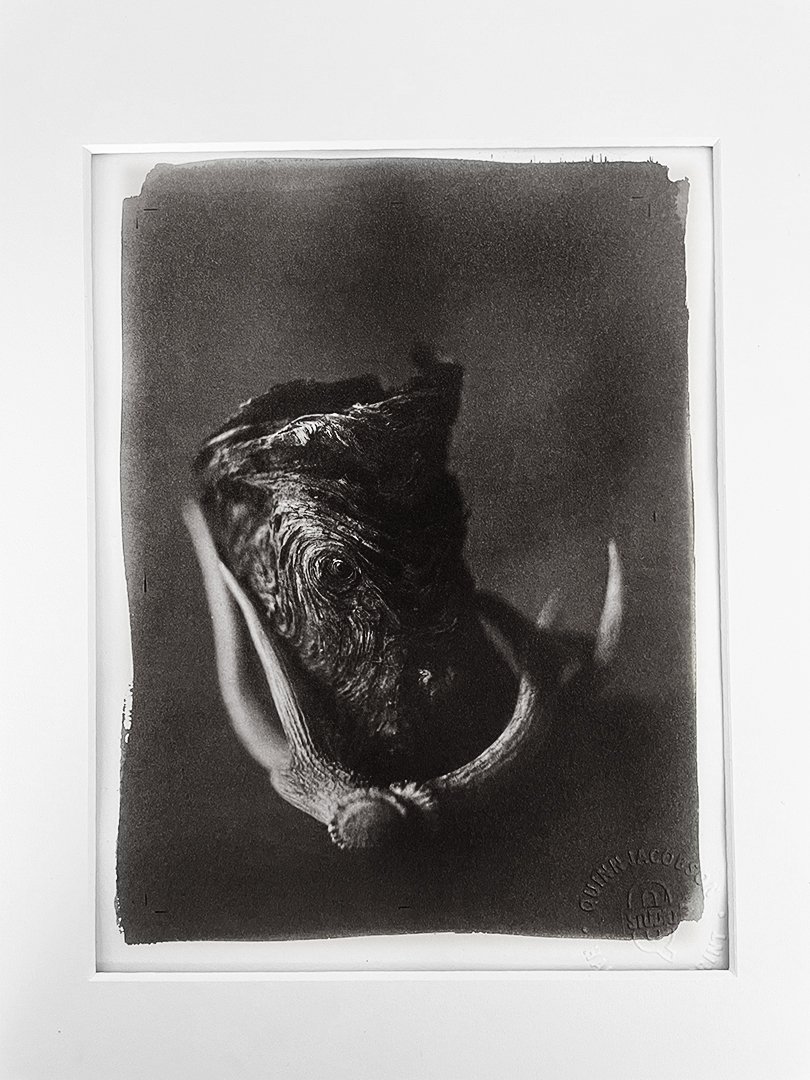“Light” This is dead Rocky Mountain barley and a small cactus flower that is blooming. This is a 10” x 10” (25,4 x 25,4 cm) RA-4 color reversal direct print (made in the camera). This is about 1 second overexposed - I really like the diptych of these.
““Man’s main concern is not to gain pleasure or to avoid pain but rather to see a meaning in his life. That is why man is even ready to suffer, on the condition, to be sure, that his suffering has a meaning.””
This coming Saturday, April 22, 2023, I’m going to read the sixth chapter of “The Worm at the Core: On the Role of Death in Life” on my YouTube show. This chapter is about symbolic immortality. What is symbolic immortality? It’s the flip side of the coin of human desiring or striving for immorality. One side of the coin is literal immortality (last week’s read), and the other is symbolic immortality. It’s a big driving force in our lives. And it’s very interesting in terms of terror management theory. If you can, join me for the reading, I’m sure you’ll find something vaguely interesting if you’re reading this.
The book really starts to take off with this chapter. To this point, the authors have laid the groundwork for the reasons we lean on repression, denial, and the transcendence of death. They’ve addressed how we use our parents when we’re children for our self-esteem, and then we separate, or individuate, and lean on culture for the all-important tools to repress or deny the knowledge of our impending death and to build self-esteem (which acts as a buffer to death anxiety). They’ve given both historical references and modern empirical evidence about how we respond to death awareness. For me, this is where these theories really take off and we begin to connect the dots.
“Humans are incredibly intelligent. On consciousness: It takes a ridiculously sophisticated cognitive apparatus to render yourself the object of your own subjective inquiry. ”
Since human beings acquired consciousness or became aware that they existed, nonexistence has become a frightening reality. Mortality is on our minds and in our thoughts; it consumes us, and we need a way to buffer, repress, or transcend it. This is true, whether we know it or not, and most don’t (it’s an unconscious activity, like most psychological events). We are so embedded or ensconced in our cultural worldview that we’re blind to what motivates our activities, shapes our desires, and drives us on a daily basis. For me, this is the most revealing feature of these ideas. We’re so far down the rabbit hole (repressing the anxiety) that we can’t make sense of these theories; we don’t understand them. That’s what they’re designed to do: keep us from thinking about becoming worm food. And over tens of thousands of years, they have become so deeply embedded in our psychological landscape that we are shielded from the knowledge of death—at least for the most part.
One way we deal with the terror of death is to transcend it; we mainly use culture to do that. Technology, religion, art, ritual, myth, family, politics, relationships, money, etc.—these all provide some form of immortality for us or ways to repress or buffer existential dread. Why are we so afraid of dying? It’s not the actual event of death that gives us anxiety (some do have anxiety about how they will die), but the knowledge of it. We are living and existing in a meaningless world. We won’t be remembered. It’s the impermanence and insignificance that give us anxiety and dread. We want to be remembered; better yet, we don’t want to die!
“Ernest Becker called this desperation ‘the ache of cosmic specialness.’ Becker states what is patently obvious to most: as humans, we constantly put ourselves at the center of the universe.”
“Life & Light” is a 20” x 20” (51 x 51 cm) these are RA-4 color reversal direct prints (made in the camera).
As Ernest Becker, the author of “The Denial of Death” (1973), pointed out, Freud was wrong. It’s not our sexual drive that motivates our behavior and psychological gymnastics; it’s our fear of death. Peter Zapffe, a Norwegian philosopher, also addressed these theories in his 1933 essay, “The Last Messiah.” Zapffe cites four coping mechanisms we use to repress death anxiety. For Zapffe, our becoming mentally over-equipped has resulted in us becoming “fearful of life itself" and of our “very being." The degree to which we are conscious of reality, which is unlike any other species, also means that we have become acutely aware of the suffering of billions of people and sentient life on the planet, as well as the planet itself.
“The Last Messiah” starts like this (bold for emphasis):
“One night in long bygone times, man awoke and saw himself.
He saw that he was naked under cosmos, homeless in his own body. All things dissolved before his testing thought, wonder above wonder, horror above horror unfolded in his mind.
Then woman too awoke and said it was time to go and slay. And he fetched his bow and arrow, a fruit of the marriage of spirit and hand, and went outside beneath the stars. But as the beasts arrived at their waterholes where he expected them of habit, he felt no more the tiger’s bound in his blood, but a great psalm about the brotherhood of suffering between everything alive.
That day he did not return with prey, and when they found him by the next new moon, he was sitting dead by the waterhole.”
Sublimation, which Zapffe calls “a matter of transformation rather than repression,” It involves turning “the very pain of living” into “valuable experiences.” He continues: “Positive impulses engage the evil and put it to their own ends, fastening onto its pictorial, dramatic, heroic, lyric, or even comic aspects.” He also notes that the essay "The Last Messiah" itself is an attempt at such sublimation. For Zapffe, sublimation is “the rarest of protective mechanisms." Most people can limit the contents of their consciousness using the previous three mechanisms (isolation, anchoring, and distraction), staving off existential angst and world-weariness. But when these forms of repression fail and the tragic cannot be ignored, sublimation offers a remedy, a way of turning the unignorable “pain of living” into creative, positive, aesthetically valuable works. (Partially Examined Life) This is where I find myself—deep into sublimation.
Meaning and Meaninglessness
Everyone has the responsibility to create meaning in their lives. There is nothing inherently meaningful in life. Life is primarily a biological process; it goes on whether we believe in something or not; it simply doesn’t matter; the world goes on. When people ask, “What is the meaning of life?” They are missing the point; there is no meaning; you have to create it, find it, search it out, apply it, and live it. The question should be, “What is the meaning in life?” Your life. Whatever that might be, I believe whatever you do to create meaning is a good thing as long as it doesn’t hurt or infringe on other people's ways of creating meaning.
If you’re religious or have a certain faith or belief in an afterlife and believe in a deity, no problem. If you belong to a sports club or a political group and find meaning and significance there, no problem. If you have a hobby—gardening, cooking, sewing, writing, painting, or photography—that’s great! If it bolsters your self-esteem, makes you feel significant, and gives you meaning, you’re on the right track.
The problem is that, a lot of times, unconscious beliefs infringe on other people's cultural worldviews; it creates hurt, discrimination, oppression, and even death (this usually happens to members of marginalized groups). Everyone needs to find something that provides them with meaning and significance. This isn’t about being right or wrong; it’s about being human and feeding self-esteem to buffer death anxiety. We all suffer from this condition (the human condition). No one gets to say, "That doesn’t apply to me." It applies to everyone.
I’m not a nihilist, but there is some truth in the “nothingness” that nihilists ascribe to, especially existential nihilism. Nietzsche said, "To live is to suffer. To survive is to find some meaning in the suffering." I do ascribe to that idea.
William Shakespeare wrote:
"Life’s but a walking shadow, a poor player that struts and frets his hour upon the stage
And then is heard no more. It is a tale told by an idiot, full of sound and fury, signifying nothing."
I titled this essay “Finding Meaning in the Meaninglessness.” It’s a difficult thing to admit, but everything is meaningless. Everything. For context, when I say meaningless, I mean it in the cosmic sense, not the personal sense. For me, all of my pictures, all of my writings and books, all of my thoughts, my degrees, my life experiences, all of my accomplishments, even my existence, are all meaningless. It’s true, and I’m fine with that truth. What I’ve found is that, while I understand this fact in the cosmic sense, it doesn’t preclude me from finding meaning and significance for myself. All of the aforementioned things are very meaningful, significant, and important to me, including my wife and daughter, who are at the top of my meaningful list, and my friendships and relationships outside of my family.
I’ve created, experienced, and lived all of it for my mental health and well-being, not for some bigger purpose or to change the world. It’s wonderful to be alive most of the time. I’m in awe of the beauty where I live. I’m amazed at the progress human beings have made over the millennia. It’s truly amazing. I’m grateful to wake up every morning.
On the surface, it may seem that I’m trying to change the world through my work, but I’m not. If no one ever read a word I’ve written, looked at a picture I’ve made, or listened to my philosophies about life, it wouldn’t matter—because it doesn’t. They’re not meaningful or important to the bigger scheme of things (cosmic); I get that, and I’m okay with that. I’ve come to terms with it. It doesn’t depress or demotivate me either. In fact, in a lot of ways, it’s freeing and maybe even emancipating in ways. It encourages me even more to express and create.
The only thing I’ve tried to do (intentionally) in my life is encourage people to consider people who are different from them as fully human and try not to do harm to “the other.” And now, with my new work, I’m trying to help people understand what these important ideas have to offer. It would be a much better world, at least for the time we’re here, if we could come to terms with our mortality. As Albert Camus said, “There is only one liberty, to come to terms with death, thereafter anything is possible.”














